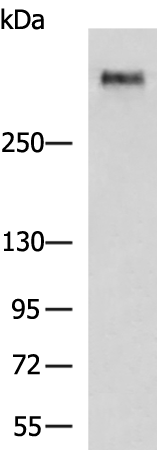

| WB | 咨询技术 | Human,Mouse,Rat |
| IF | 咨询技术 | Human,Mouse,Rat |
| IHC | 1/50-1/100 | Human,Mouse,Rat |
| ICC | 技术咨询 | Human,Mouse,Rat |
| FCM | 咨询技术 | Human,Mouse,Rat |
| Elisa | 1/5000-1/10000 | Human,Mouse,Rat |
| Aliases | MG1; MUC5; MUC9; MUC-5B |
| WB Predicted band size | 596 kDa |
| Host/Isotype | Rabbit IgG |
| Antibody Type | Primary antibody |
| Storage | Store at 4°C short term. Aliquot and store at -20°C long term. Avoid freeze/thaw cycles. |
| Species Reactivity | Human |
| Immunogen | Synthetic peptide of human MUC5B |
| Formulation | Purified antibody in PBS with 0.05% sodium azide and 50% glycerol. |
+ +
以下是关于MUC5B抗体的3篇代表性文献摘要:
---
1. **文献名称**:*MUC5B Promoter Variant and Respiratory Dysfunction in Idiopathic Pulmonary Fibrosis*
**作者**:Seibold MA, et al.
**摘要**:该研究揭示了MUC5B基因启动子区域的变异与特发性肺纤维化(IPF)的显著关联,发现MUC5B在IPF患者肺组织中过度表达,且其抗体检测可能作为疾病进展的潜在生物标志物。
---
2. **文献名称**:*Airway Mucin MUC5B is Upregulated in Chronic Inflammatory Lung Diseases*
**作者**:Rose MC, Voynow JA
**摘要**:文章系统综述了MUC5B在慢性呼吸道疾病(如COPD和囊性纤维化)中的作用,指出炎症因子(如IL-1β和TNF-α)通过调控MUC5B表达导致黏液分泌过多,相关抗体可用于研究其病理机制。
---
3. **文献名称**:*Anti-MUC5B Antibodies in Primary Sjögren’s Syndrome*
**作者**:Crowley JT, et al.
**摘要**:该研究首次报道抗MUC5B抗体在干燥综合征患者唾液中的特异性存在,提示其可能作为诊断自身免疫性唾液腺损伤的新型血清学指标,并探讨了抗体与腺体功能障碍的相关性。
---
如需扩展,还可补充:
4. **文献名称**:*MUC5B Modulates Pseudomonas aeruginosa Adhesion in Chronic Respiratory Infections*
**作者**:Roy MG, et al.
**摘要**:研究利用MUC5B抗体证实其在呼吸道感染中的双重作用:过量分泌导致黏液滞留,但低表达可能增加铜绿假单胞菌的黏附风险,为治疗策略提供新视角。
The MUC5B antibody targets the MUC5B glycoprotein, a key component of the mucin family responsible for forming protective mucus layers on epithelial surfaces. Primarily expressed in secretory tissues like respiratory tracts, salivary glands, and the cervix, MUC5B contributes to mucosal hydration, pathogen trapping, and lubrication. Its aberrant expression is linked to pathologies such as idiopathic pulmonary fibrosis (IPF), chronic obstructive pulmonary disease (COPD), and certain cancers, making it a critical biomarker and therapeutic target.
MUC5B antibodies are widely used in research to detect protein localization, expression levels, and glycosylation patterns via techniques like immunohistochemistry (IHC), Western blotting, and ELISA. These antibodies help elucidate MUC5B’s role in mucus overproduction in chronic respiratory diseases or its paradoxical protective association with IPF risk variants. Due to MUC5B’s complex structure—large size, repetitive domains, and heavy O-glycosylation—antibody development requires careful epitope selection to ensure specificity. Commercial MUC5B antibodies are typically raised against conserved regions (e.g., N- or C-termini) to minimize cross-reactivity with other mucins. Recent studies also explore MUC5B’s potential as a diagnostic tool or therapeutic target, driving demand for high-affinity, validated antibodies. Challenges remain in standardizing detection methods due to MUC5B’s structural variability across tissues and disease states.
×